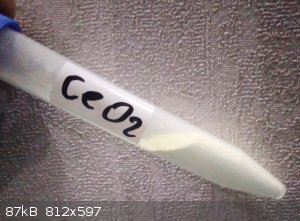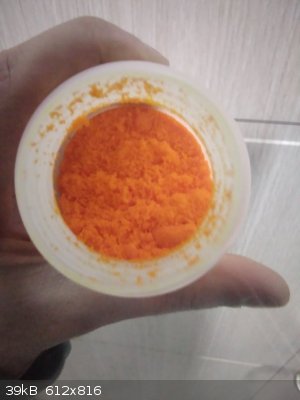
vano - 18-1-2022 at 09:45
I just thermally decomposed ceric ammonium nitrate. I heated it at 200 C. then raised the temperature to 250-280 degrees and calcine it for another 2
hours.


woelen - 19-1-2022 at 10:57
How reactive is this CeO2? Can it be dissolved in acids? I have some CeO2, and that material is extremely inert and cannot be dissolved in
concentrated acids, not even by boiling the acid. So, I am wondering how reactive your product is. I would like to have some CeO2, which is
sufficiently reactive that it can be used to make other Ce-salts.
Bedlasky - 19-1-2022 at 13:30
Why did you make useless CeO2 from usefull ammonium cerium(IV) nitrate?
Woelen: https://www.sciencemadness.org/whisper/viewthread.php?tid=15...
I read that molten bisulfate should also dissolve CeO2.
vano - 20-1-2022 at 07:28
woelen i don't know to tell you truth. When i try i will write here.
Bedlasky i know how useful it is, but have a lot and i also want other cerium compounds for example tetravalent sulfate. Exept that i love when i have
new reagent.
Lion850 - 20-1-2022 at 21:42
Hi Woelen did you try hot concentrated sulphuric acid?
See my post
http://www.sciencemadness.org/talk/viewthread.php?tid=155085...
woelen - 21-1-2022 at 01:16
I tried boiling HCl (30%), boiling H2SO4 (40% or so).
I did not try the really hot things like near boiling hot concentrated H2SO4 or molten NaHSO4 (the hydrate "melts" at 58 C, but that is no real
melting, it just is losing water of crystallization and then dissolving in its own lost water of crystallization, real melting occurs well over 300
C).
I might try the hot H2SO4-route. The molten NaHSO4 seems too dangerous to me with glassware, and when using other materials, then you get a
contaminated product (the cerium(IV) is strongly oxidizing and most likely will oxidize many metals).
